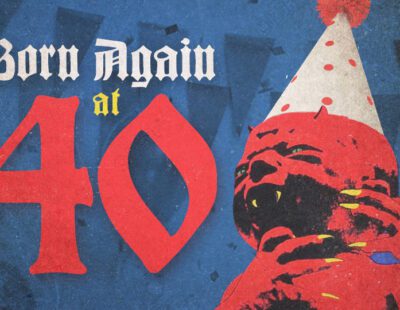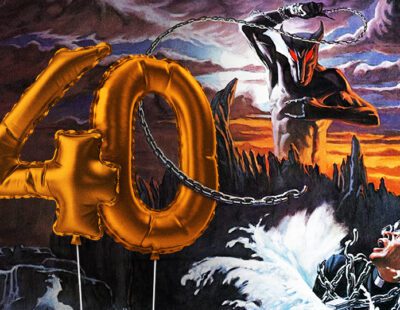
Thirty years ago yesterday, Chicago noise rock pioneers Big Black released their final record, Songs About Fucking. Nearly every piece of the album cemented it as an instant classic. Pitchfork called it the 54th best album of the 80s. According to Last.FM, all of Big Black’s most listened-to songs are contained on the album.
Where most noise acts to this day succeed at making loose, abrasive dins, Big Black were focused, and never more so than in 1987. The title, like most of its lyrics, thumbs its nose at the foundational notions of rock music while at the same time re-interpreting them in a brutally honest way. The minimal album art, harvested from a pornographic Japanese comic book, hints at raw excess within.
Big Black broke up before the record dropped, cementing it as one of extreme guitar music’s great mic drops. Three decades later, Songs About Fucking still sounds vital and incorrigibly furious in a way that many noise bands still do not.
The Ingredients of Big Black
Guitarist and singer Steve Albini formed Big Black in 1981, many years before he became more well known as a producer and analog technology enthusiast. Big Black’s sound came to center around roughly four ingredients.
First, Albini and fellow guitarist Santiago Durango’s opposing clanking and muscular guitar tones. Albini went to great and obscure lengths to conjure unheard tones for Big Black, including custom-made notched metal picks which would strike a string twice with one pluck, as well as a custom built guitar he called the “Black Sled.”
Second, bassist Dave Riley’s rhythmic and vaguely funk-tinged bass work. Riley worked as an assistant audio engineer for George Clinton prior, and the slightest hint of P-funk shines through in his somewhat melodic bass sensibility.
Third, Big Black employed a Roland TR-606 drum machine in lieu of a live drummer. Albini used the machine in service of busy, driving compositions that could stand on their own without other instruments. The Roland drum tracks may be Big Black’s most readily identifiable influence. Songs About Fucking predates Godflesh and Nine Inch Nails, among others.
Finally, Albini’s lyrics explored dark, real-world subjects with a disgusted and confrontational bent. In a 1987 interview with Melody Maker, Albini said “I just happen to have a fascination for certain kinds of human interaction – where people try to dominate each other, or the means of expression people resort to when pushed to their absolute limits. When people go beyond their training and morals and do exactly what their urges tell them to do, they are, in a sense, being most true to themselves. What intrigues me is that here are situations and phenomena that are severe, and yet I can’t understand them.” On Songs About Fucking, he deadpanned his way through tunes about hollow commercialism, psychoactive amino acids, murderous physicians and Pablo Escobar’s notorious (fictional) method of execution, the Colombian Necktie. In the liner notes he went on to dedicate the album to “all the bands who don’t write love songs.”
Side A
The first half of Songs About Fucking has aged particularly well. In the Decibel Hall of Fame edition for Goat by The Jesus Lizard, that band says Albini encouraged them to put their strongest tunes on the first side of the record. Albini may have come across that formula while tracking Songs About Fucking’s first half in London. In a 1992 interview with Maxmimumrocknroll, he said the first six songs on the record constitute the band’s best work.
“The Power of Independent Trucking” explodes out of the gate and makes way for a brooding cover of Kraftwerk’s “The Model.” Then comes maybe Albini’s most vitriolic vocal performance in “Bad Penny,” one of the only songs from the record which made its way into Big Black live sets. Each of these tunes showcases the band’s uncompromising attitude, but does so through catchy songwriting.
The Tour Diary
Albini kept a detailed tour diary during the final run of Big Black shows. It’s a fun and 100% necessary read, but definitely not the sort of thing that would fly if published for the first time today by a young up-and-coming band like Big Black was in 1987 (Albini later said in a Reddit AMA that he was “pretty full of himself back then”). Members of New Order, Sonic Youth and other beloved bands make appearances.
In the band’s most triumphant moment, Bruce Gilbert and Graham Lewis join Big Black in London for a performance of Wire’s “Heartbeat.” The whole thing is immortalized on video. In a 1992 interview with NME, Albini said “on the live record and video we were probably as good as we were ever gonna be,” about the performance.
In that diary, Albini says he’s glad about Big Black breaking up. Durango had decided to pursue law school instead of music while Riley’s alcohol intake began to pose a more serious problem. In the diary, a sober and embittered Albini rejects both the party lifestyle of touring bands and the unthinking crowds that Big Black was beginning to attract. In a 2008 interview with Impose, Albini refines those sentiments with 21 years of clarity.
“Well, we probably would have carried on [if Durango had not continued schooling and Riley had sobered up], but I think we kind of reached a natural stopping point for that band. I felt like we had only made good records until that point, we had only played good shows to that point, and we had just gotten to a point where our audience was large enough that we could identify elements of it that we didn’t like. I don’t think we would have had the insight to end it without Santiago leaving.”
The Last Show
Big Black played their final show in Seattle, Washington on August 9, 1987 at a venue called the Georgetown Steam Plant. Originally a literal power plant that serviced Seattle’s once-ubiquitous trolley system, the location is now a museum but was at that time abandoned. The venue, ironically, had no power so show promoter Larry Reid had to rent a generator for the stage and another for the sound board and recording equipment.
Located inside of a metal warehouse near Boeing field, the building is cavernous and reverberative. The racket Albini, Durango and Riley made was enormous. Albini and co demolished their instruments at the set’s end and let off a brick of Black Cat fireworks purchased over Fourth of July weekend from an Indian reservation. Fortunately it remains immortalized in video (look for Kurt Cobain in the crowd at 31:14).
It is difficult to think of a more fitting location to end Big Black. Once a source of industrial power, the locale is now an insular attraction for the technologically and historically inclined, a testament to the power of pre-Information Age engineering.
“Steve had asked me to book his last show and to do something special that would suit him,” says Reid. At the time the fire department strictly limited the attendance to 600. “They were particularly popular here. Seattle had a very active music scene, and Big Black drew big audiences. People respected Steve as much as much for his attitude and independent spirit as for his music.”
A who’s who of Seattle alternative and extreme rock luminaries attended the show. Kim Thayil of Soundgarden took tickets at the door. The event constituted “a metaphorical passing-of-the-torch to the Seattle music scene,” Reid says. From this perspective the grunge movement’s ascendancy and its indelible ongoing effect on extreme guitar music all stems, in part, from Big Black’s unforgettable mic drop.
And that was all she wrote. Albini flew home that night to go to his day job, and Songs About Fucking went into circulation not long after. The band played a brief reunion gig without Riley, and played no songs from the record. Thirty years later, though the project is no more, Big Black just keeps on pounding.





